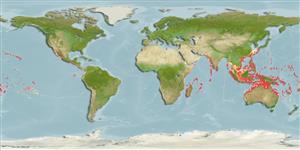Common names from other countries
>
Tetraodontiformes (Puffers and filefishes) >
Monacanthidae (Filefishes)
Etymology: Cantherhines: Greek, kanthos = the outer or inner corner of the eye, where the lids meet, 1646 + Greek, rhinos = nose (Ref. 45335).
Environment: milieu / climate zone / depth range / distribution range
Ecologia
marinhas associadas(os) a recifes; não migratória; intervalo de profundidade 0 - 70 m (Ref. 89467), usually 6 - 35 m (Ref. 9710). Tropical; 32°N - 32°S
Indo-Pacific: East Africa to French Polynesia, north to Japan and Hawaii. Eastern Pacific: Mexico to Colombia (Ref. 9318).
Tamanho / Peso / Idade
Maturity: Lm ? range ? - ? cm
Max length : 38.0 cm TL macho/indeterminado; (Ref. 30573); common length : 25.0 cm TL macho/indeterminado; (Ref. 30573)
Descrição suscinta
Chaves de identificação | Morfologia | Morfometria
Espinhos dorsais (total) : 2; Raios dorsais (total) : 34 - 39; Espinhos anais: 0; Raios anais : 28 - 35. Greyish brown to yellowish brown with about 12 vertical dark brown bars; lips whitish; male adults with orange peduncle spines; soft dorsal, anal and pectoral fins pale yellowish; caudal fin orange with dusky rays (Ref. 4421). Sexually dimorphic with males having longer and deeper orange peduncular spines and deeper orange tail and eyes (Ref. 37816).
Inhabit offshore coral reefs usually solitary or in pairs (Ref. 5503, 48637). Common in surface waters around oceanic islands (Ref. 9318). Benthopelagic (Ref. 58302). Shy species, usually retreating quickly into caves or large crevices of the reef (Ref. 48637). Juveniles are pelagic, seen under floating objects (Ref. 9318). Feed on tips of branching corals, algae, sponges, sea urchins, and mollusks (Ref. 1602). Minimum depth reported taken from Ref. 128797.
Ciclo de vida ou comportamento de acasalamento
Maturities | Reprodução | Spawnings | Egg(s) | Fecundities | Larvas
Myers, R.F., 1991. Micronesian reef fishes. Second Ed. Coral Graphics, Barrigada, Guam. 298 p. (Ref. 1602)
Status na Lista Vermelha da UICN (Ref. 130435)
CITES (Ref. 128078)
Not Evaluated
Ameaça para os humanos
Harmless
Uso pelos humanos
Pescarias: espécies comerciais; Aquário: Espécies comerciais
Ferramentas
Relatórios especiais
Baixar XML
Fontes da internet
Estimates based on models
Preferred temperature (Ref.
115969): 24.3 - 28.9, mean 27.6 (based on 1090 cells).
Índice de diversidade filogenética (Ref.
82804): PD
50 = 0.5002 [Uniqueness, from 0.5 = low to 2.0 = high].
Bayesian length-weight: a=0.02399 (0.01377 - 0.04179), b=2.93 (2.78 - 3.08), in cm Total Length, based on LWR estimates for this species & (Sub)family-body (Ref.
93245).
Nível Trófico (Ref.
69278): 3.1 ±0.33 se; based on food items.
Resiliência (Ref.
120179): médio(a), tempo mínimo de duplicação da população 1,4 - 4,4 anos (Preliminary K or Fecundity.).
Fishing Vulnerability (Ref.
59153): Low to moderate vulnerability (28 of 100).
